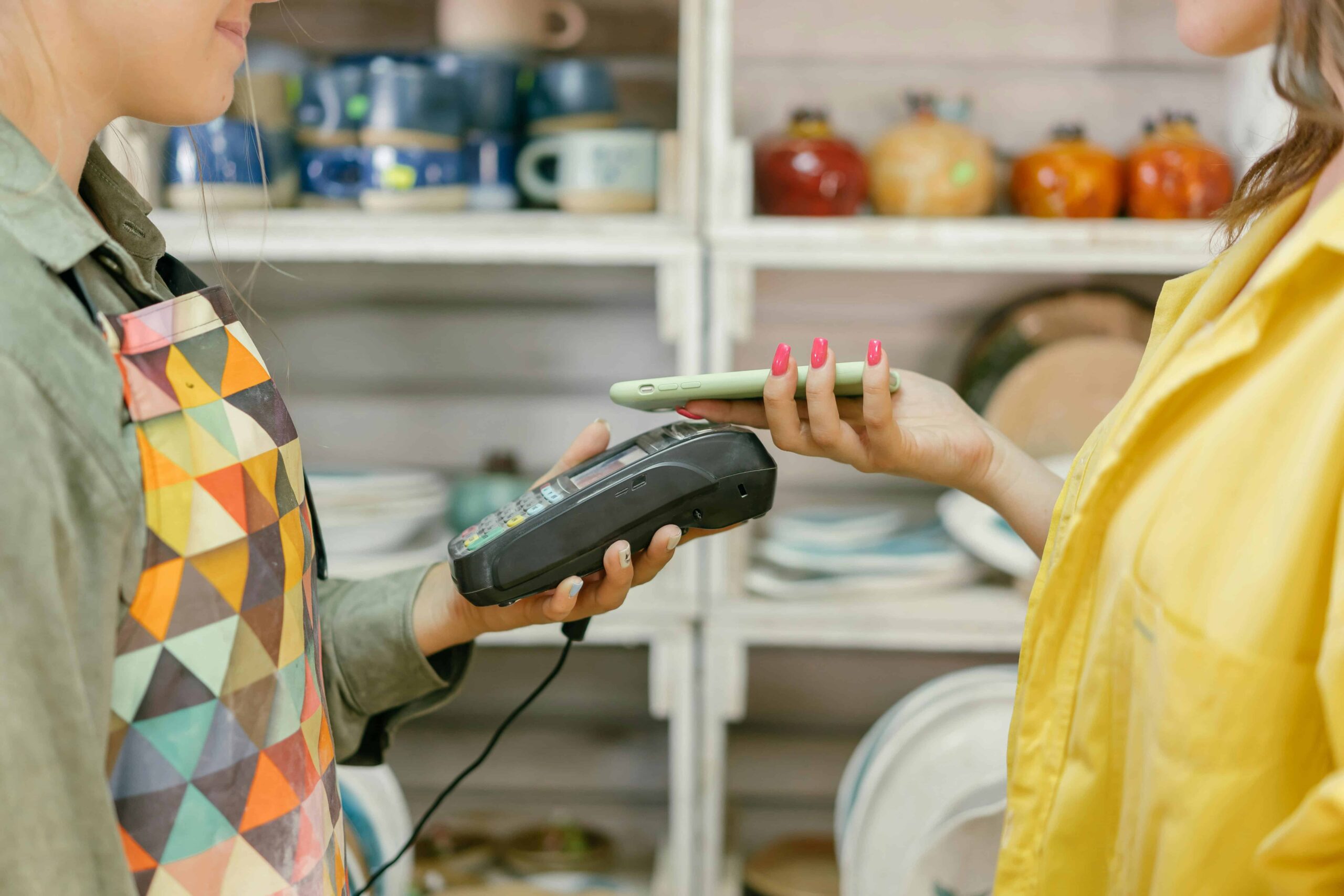Top 5 Point of Sale Apps
Looking for a way to handle payments, track sales, and manage customers in your store or on the fly? Check out these Point of Sale apps.

Point of sale apps (POS) are the place in a store or elsewhere where the actual business transaction takes place. Usually, it involves an exchange of money, whether cash, check, credit card, or digital bank tranfer for merchandise or a service. Payment is taken and a receipt is given.
Point of sale systems make it all happen, linking hardware, such as a cash register or credit card reader, with software that will process credit and debit card payments; managing inventory; tracking sales data, and collecting customer information. Many POS systems will even sync with accounting software, creating a complete financial management package for your operation.
POS systems began as hard-wired in-store setups, where all the software ran on an on-site computer and linked to register terminals. Today, many point of sale apps are cloud-based, run as apps on tablets and smartphones, and they offer tremendous resources to small business owners at cost-effective prices. Most POS systems are hybrids, with certain information stored on a local computer while offering the freedom and flexibility of running in the cloud.
What to look for in a POS
Every business has its own priorities, but here are the things you’ll want to consider when deciding what POS app is right for your business:
- How easy is a POS app to use?
- What customer support is available?
- How much does it cost?
- What functionality does it offer?
- What kind of reports does it generate?
- How easy is it to access your data?
- How secure is the app?
- Does the app offer end-to-end encryption?
- What kind of hardware does it require?
Here are some of the top point of sale apps available today.
1. Square
Square has been around since 2009, making it one of the industry’s cloud-based POS system pioneers, allowing merchants and individuals to accept debit and credit cards on their smartphone or tablet.
Pros of Square
- It can be used online or offline, although you’ll be responsible for any transactions taken while offline that get declined or result in chargebacks.
- It can be customized for your products with photos, names, and prices.
- For restaurants, tips can be calculated and added by customers with one click.
- Receipts get sent via email or text, and a printer can be hooked up for hard copies.
- Punch card loyalty programs can be integrated.
- There is a growing suite of associated products available for an extra cost, including an online marketplace, online invoicing, and an online appointment service.
- There are no monthly fees or setup costs, although there is a charge for hardware such as an iPad stand or receipt printer. There are no monthly contracts or termination fees.
Cons of Square
- Square charges a fee of 2.6% + 10 cents on every credit card transaction for swiped cards. Also they charge 3.5% plus 15 cents when the info is entered manually, which is more than most conventional credit card processors.
- Square also requires a card reader to work. Card readers can cost anywhere from $49-$299.
- Physical gift cards for your business must be purchased from Square ($1.50 per card) to work with Square. Square also supports digital gift cards.
- Square uses its own private algorithm to decide whether to approve each transaction, and puts automatic holds on transactions it decides are risky. This can result in a long delay in being paid, or sometimes even the deactivation of a merchant’s account.
- Some customers say contacting support can be very frustrating, with long wait times.
Square is available for both Apple and Android. Most Square plans require a monthly fee, which could be up to $89, depending on the plan. It can be a good solution if you’re looking for something easy to set up with no long-term commitment, especially if you do business remotely, such as at street fairs or in a kiosk. Be aware of the potential fund-holding issues for larger volume merchants and the reported difficulty in reaching customer service.
2. Stripe
Stripe has been a go-to payment platform for over a decade, known for powering online businesses with its flexible, developer-friendly tools that allow merchants to accept payments via credit cards, debit cards, and other methods.
PROS OF STRIPE
- It supports a wide range of payment methods, including credit cards, Apple Pay, Google Pay, and international options like Alipay and SEPA.
- Ideal for subscription businesses, with built-in tools for managing recurring payments and invoicing.
- The dashboard provides detailed insights into transactions, sales, and financial reports.
- Fraud prevention is integrated through Stripe Radar, which uses advanced algorithms to detect and stop risky transactions.
- Compatible with popular platforms like Shopify, WooCommerce, and BigCommerce, as well as custom-built systems.
- There are no setup or monthly fees; the pricing is straightforward at 2.9% + 30 cents per transaction, with volume discounts available for larger businesses.
- Scalable for businesses of all sizes, from startups to enterprise-level companies.
- Stripe offers additional features like one-click checkout, billing, tax, and revenue recognition.
CONS OF STRIPE
- Stripe is mainly designed for online payments, with fewer options for in-person transactions. Though Stripe Terminal does provide some options for in-person transactions.
- Setting up advanced features may require technical expertise, which could be a barrier for non-developers.
- Like many payment processors, Stripe may place holds on funds or delay payouts if it flags transactions as risky.
- Some users report slow response times and difficulty resolving complex issues with customer support
- International transactions and currency conversions come with additional fees, which can increase costs for businesses with global customers.
Stripe works on web and mobile platforms, making it ideal for online businesses, e-commerce, and subscription services. It’s great for companies with technical resources to customize their setup but may not suit businesses needing strong offline payment options or quick customer support.
3. Helcim POS
Helcim is a versatile point-of-sale (POS) system designed for small and medium-sized businesses, offering transparent pricing and robust tools for managing in-person and online payments.
PROS OF HELCIM
- Transparent pricing with no hidden fees; transaction rates decrease as your sales volume increases.
- Supports both in-person and online payments, making it a flexible solution for various business models.
- Offers a feature-rich POS system that includes inventory management, customer tracking, and invoicing.
- Customizable receipts and professional-looking payment pages for online transactions.
- No long-term contracts or cancellation fees, providing flexibility for businesses.
- Includes tools for managing recurring payments and subscriptions.
- Integrates easily with accounting software like QuickBooks and other business tools.
- Excellent customer support with responsive and knowledgeable assistance.
CONS OF HELCIM
- Helcim’s upfront setup and learning curve may be challenging for non-tech-savvy users.
- Helcim hardware, like the Smart Terminal, is fairly expensive, at $300-$400.
- While pricing is competitive for high-volume businesses, it may not be as cost-effective for very small or infrequent transactions.
- Helcim is currently available only in the U.S. and Canada, limiting its use for businesses with international operations.
Helcim is a great choice for small and medium-sized businesses looking for a transparent, flexible POS solution. It’s especially suitable for those who need both in-person and online payment options, along with advanced business tools. However, it might not be the best fit for very small businesses, those outside the U.S. or Canada, or those needing free hardware.
4. Toast
Toast is a point-of-sale (POS) system built specifically for restaurants, offering a comprehensive set of tools to streamline operations and enhance customer experiences.
PROS OF TOAST
- Designed for restaurants, with features like menu management, table-side ordering, and split check functionality.
- Integrates seamlessly with kitchen display systems to improve communication and speed up service.
- Includes options for online ordering, delivery, and contactless payments to meet modern dining preferences.
- Built-in tools for managing tips, employee shifts, and payroll.
- Robust reporting and analytics to track sales, inventory, and performance.
- Offers customer engagement tools like loyalty programs and gift card management.
- Customizable hardware, including handheld devices for table-side service.
- 24/7 customer support to help resolve issues quickly, but support quality varies by tier.
CONS OF TOAST
- Requires specific Toast hardware, which can be expensive upfront (more than $600).
- Monthly software subscription ranges from $0 to more than $165.
- The learning curve can be steep for new users or non-technical staff.
- Primarily focused on restaurants, so it may not be suitable for other types of businesses.
- Contract terms can include long-term commitments, limiting flexibility for some businesses.
Toast is an excellent choice for restaurants looking for a powerful POS system tailored to their needs. It’s especially suited for those seeking advanced features for both front-of-house and back-of-house operations. However, it may not be the best fit for non-restaurant businesses, small establishments with limited budgets, or those looking for transparent pricing and contract terms.
5. Clover
Clover, owned by Fiserv, is a versatile point-of-sale (POS) system that offers customizable solutions for various business types, including retail, restaurants, and service providers.
PROS OF CLOVER
- Highly flexible, with a wide range of hardware options to suit different business needs, from countertop terminals to mobile card readers.
- Offers robust POS tools, including inventory tracking, sales reporting, customer management, and contactless readers.
- Allows businesses to choose their own merchant service provider, offering flexibility in payment processing options.
- Includes features for customer engagement, such as loyalty programs, gift cards, and email marketing.
- Integrates with third-party apps for added functionality, such as accounting, scheduling, and online ordering.
- User-friendly interface, making it easy for staff to learn and operate.
- Cloud-based system ensures data accessibility across devices and locations.
- 24/7 customer support available for troubleshooting and assistance.
CONS OF CLOVER
- Initial hardware costs can be high, especially for small businesses ($50-$1700, depending on your needs).
- Monthly software subscription fees can add up, depending on the selected plan and add-ons.
- Limited offline functionality, which may disrupt operations during internet outages.
- Customization options can be overwhelming for businesses seeking a simpler setup.
- Some advanced features require additional paid apps, increasing overall costs.
Clover is an excellent choice for businesses seeking a scalable and customizable POS system with robust tools for managing operations and engaging customers. However, the upfront costs and ongoing subscription fees may not suit businesses with tighter budgets or simpler needs.
Using POS systems
Modern POS systems have transformed from simple cash registers into powerful tools for managing transactions, inventory, and customer relationships while providing valuable insights. The right POS system depends on your business needs, such as ease of use, cost, and functionality.
Solutions like Square and Stripe excel in simplicity and online integration, while Toast and Clover offer advanced features for restaurants and other businesses. Helcim stands out for transparent pricing and flexibility. A well-chosen POS system boosts efficiency, ensures secure transactions, and helps your business thrive.
Grow Your Digital Tools
Accion Opportunity Fund and Ripple are partnering to launch Ripple Digital Leap Forward, a fully virtual accelerator program designed to unlock opportunity for 50 business owners.










